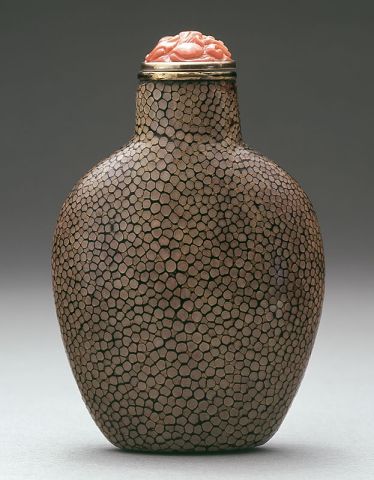
Bottle ID: 679
SHAGREEN
Date: 1723-1850
Height: 70 mm
Shagreen on wood, with black lacquer and gilt-bronze, of flattened ovoid form with a slightly tapering cylindrical neck and at the base a flat oval foot, the wood bottle covered overall on its outer surfaces (except the lip) with shagreen, the interior lacquered in black, the lip gilt-bronze. (Note: the gilt-bronze lip is a replacement of a missing lip, made by Lorenz Denney in 2005).
Similar Examples:
Crane Collection no.231 and no. 917.
Moss, Hugh, Victor Graham and Ka Bo Tsang. A Treasury of Chinese Snuff Bottles - The Mary and George Bloch Collection, 2009, Vol. 7, Part 1, p. 247, no. 1566.
Hidden Treasures of the Dragon - Chinese Snuff Bottles from the Collections of Humphrey K.F. Hui, Margaret Polak and Christopher C.H. Sin, 1992, p. 141, no. 285.
Provenance:
Hugh Moss (HK) Ltd.
Robert Kleiner, 2005
John Ault Collection, 2005
Only one other early bottle of this material, which has traditionally been identified as sharkskin in the West but is likely to come from one of the ray family of fish, such as the pearl ray, Hypolophus sephen, is recorded. It was in the Cussons Collection and is now in the Bloch collection, and is of a darker color, but of very similar form. The black color of the other example is the result of staining, and it may be that the Crane bottle was also stained black in the areas of skin surrounding the calceous bumps, however the Chinese also stained shagreen by coloring the reverse side of the skin using vegetable dyes. The skin of the Crane bottle is more polished than the Bloch example, revealing a larger area of the calceous material and giving the impression of a paler color.
There is a relevant entry in the Imperial Archives for the first year of the Yongzheng period (1723):
“On the twenty-fourth day of the third month, Bao De delivered one piece of black lizard with instructions to make it into a snuff bottle – the order was completed by the Palace workshops in the fourth month, on the eleventh day”.
It is possible that the record refers to this sort of material and that it was simply wrongly identified as lizard.
All other known shagreen snuff bottles are considered to have been made in the second half of the twentieth century, perhaps even as a response to the publication of the Cussons bottle and the comment that it was important because it was unique. The modern ones tend, although not in every case, to be unpolished, leaving the surface rough.
< Back to full list

 English
English 中文
中文